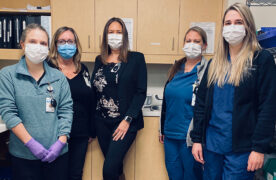By Meagan Quinlan RPh, BScPhm, BSc, PharmD,
Manager, Juravinski Hospital and Cancer Centre
Please note that on March 23, 2020, Council approved an extension to the deadlines for implementation of the non-sterile compounding standards. This change is in recognition of the evolving COVID-19 pandemic situation and the need for pharmacy professional to focus on continuity of care and minimizing public risk. The updated deadline dates are:
- Phase 2: July 1, 2021 – Personnel Training and Quality Assurance
- Phase 3; January 1, 2022 – Facilities and Equipment
The National Association of Pharmacy Regulatory Authorities (NAPRA) published the new Model Standards for Pharmacy Compounding of Non-Sterile Preparations with an accompanying Guidance Document for implementation. The Ontario College of Pharmacists requires all pharmacies engaging in Non-Sterile Compounding activities to comply with the NAPRA standards, using the following phased approach:
Phase 1: Assessing Risks and Gaps – January 1, 2020
Phase 2: Personnel Training and Quality Assurance – July 1, 2020
Phase 3: Facilities and Equipment – January 1, 2021
The following article provides a step-by-step description of the measures taken by Hamilton Health Sciences staff to prepare for the implementation of Phase 1.
RISK ASSESSMENT
The first step in preparing for Phase 1 of implementation is to evaluate your current practice with a risk assessment. A Risk Assessment, outlined on page five of the NAPRA standards, is designed to identify individual compounding requirements in order to minimize environmental contamination and protect personnel.
The following must be considered when completing a risk assessment for your pharmacy or organization:
OBTAIN ORGANIZATIONAL SUPPORT
Ensure senior management is engaged and aware of the new NAPRA Standards and OCP’s mandate for pharmacy compliance with the Model Standards for Pharmacy Compounding of Non-Sterile Preparations by 2021. Some facilities may require capital investment or alternatives to continue providing these services to patients.
Leaders can assist by identifying key stakeholders to form a working group. While not all stakeholders will be engaged in the entire process, a working group should include representatives from pharmacists, pharmacy technicians, management, health information systems and housekeeping.
REVIEW YOUR SITE-SPECIFIC NON-STERILE PREPARATIONS
When completing the risk assessment, each compound should be reviewed to determine if the non-sterile preparation is still being utilized or is available commercially from a manufacturer, eliminating the need for compounding. (Processes no longer being used can be archived.) A risk assessment must then be performed to minimize contamination of each preparation and ensure protection of compounding personnel. The Decision Algorithm for Risk Assessment in the Guidance Document for Pharmacy Compounding of Non-Sterile preparations should be utilized to assess each preparation compounded at your centre.
STEP 1. DETERMINING HAZARDOUS RISK
Each compound should be reviewed to determine if the product is found on the NIOSH list or listed in the Hazardous Products Act. Pertinent information relating to the type of hazardous risk can also be located on a safety data sheet. If hazardous drugs are identified, it is important to determine the types of hazardous drug (anti-neoplastic, reproductive risk) or risk to the compounder (inhalation risk) and how this will apply to your pharmacy.
STEP 2. DEFINE SMALL QUANTITIES
When completing the Decision Algorithm and determining if small quantities are being compounded, it is important to ensure that you have appropriate documentation to support the ‘small quantities’ being compounded. A pharmacy must be able to monitor the quantities being compounded and appropriately assess and respond when quantities increase beyond definition. A key consideration when assessing small quantities being compounded is the effect of cumulative risk to personnel. How do we account for cumulative risk? How is that rationalized in your policies and procedures, if you have deemed small quantities part of your pharmacy practice?
STEP 3: DETERMINING LEVEL REQUIREMENTS
Your risk assessment may identify products needing alternative level requirements for compounding. If you have the appropriate facilities available, the Master Formulation Record for the specific preparations can be updated to indicate appropriate level requirements, rationale for risk assessment and evidence-based references for risk mitigation strategies. The Guidance Document provides a comprehensive list of approved references for appropriate handling of hazardous drugs and materials. Staff education should also be completed to reinforce awareness of procedural change and the need to plan for any possible disruption to work flow. It is important to ensure proposed changes are clearly understood by all personnel.
Some pharmacies may also identify products necessitating an alternative level requirement that the facility is unable to fulfill. If the pharmacy must continue compounding a specific preparation to ensure continuity of patient care without appropriate facilities, the master formulation must indicate the risk for compounding the preparation. Additional evidence-based risk mitigation strategies must be put into place to alleviate risk until the facility becomes compliant. This may include changes to workflow, using additional equipment, procedural changes, including steps such as wetting of powders preventing aerosolization, and containment strategies. The physical characteristics of each hazardous drug should also be considered. All water soluble drugs are suitable for dissolve and administer systems, limiting personnel exposure.
STEP 4: REVIEW THE RISK TO THE PREPARATION
All preparations must be compounded in a designated area free of interruption. The area must facilitate products in an environment free of contaminates including allergens, particulate and dust. Reviewing risks to the preparation is directly related to your gap analysis and cleaning procedures. Your gap analysis should include a review of your facility, identifying appropriateness of storage, lighting, ventilation, water supply, work surfaces and furniture. If the gap analysis identifies facility deficiencies, senior management should be notified regarding potential risk to personnel and preparation. The working group should also be engaged during this review to develop appropriate cleaning procedures for all work surfaces, equipment and furniture. Procedures and frequency of cleaning is an important component to mitigating preparation risks.
The standards play an important role in protecting patients. It is the responsibility of the designated manager, pharmacy manager and pharmacy professionals to ensure they are up-to-date on the standards and well on their way to achieving implementation.
To learn more, visit the Non-Sterile Compounding Key Initiative on the College’s website.













